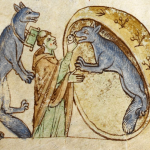When a werewolf is injured in its wolf form, the wound sympathetically carries over to the human form and may eventually reveals the identity of the werewolf. However, the werewolf’s increased vitality causes him to heal much more quickly than an ordinary person, and to be able to tolerate injuries that would incapacitate the average man or woman.
Eliphas Levi, the occultist, who considered the werewolf to be an astral projection, confirmed that “the blows inflicted on the werewolf really wound the sleeper by the odic and sympathetic conjestion of the astral light and by the correspondence of the immaterial with the material body”.

This pecuharity of the wound dealt to the werewolf being reproduced in the human being is emphasized by an incident which occurred about 1588 in a tiny village situated in the mountains of Auvergne. A gentleman was gazing one evening from the windows of his castle when he saw a hunter he knew passing on his way to the chase. Calling to him, he begged that on his return he would report what luck he had had.
The hunter after pursuing his way was attacked by a large wolf. He fired off his gun without hitting the animal. Then he struck at it with his hunting knife, severing one of the paws, which he picked up and put in his knapsack. The wounded wolf ran quickly into the forest. When the hunter reached the castle he told his friend of his strange fight with a wolf, and to emphasize his story opened his knapsack, in which to his horror and surprise he saw, not a wolf’s paw as he had expected, but the hand of a woman which had a gold ring on one of the fingers.
The owner recognised the ring as belonging to his wife, and hastening into the kitchen to question her he found her with one arm hidden beneath the folds of a shawl. He drew it aside and saw she had lost her hand. Then she confessed that it was she who, in the form of a wolf, had attacked the hunter. She was arrested and burnt to death soon afterwards at Ryon.
In another variation of the werewolf story, the human being retains a material object acquired by his animal replica and is freed thereby from his obsession.
One theory, presented by P. E. I (Issac) Boneits in “Real Magic” (1971), explains that sympathetic wounding actually is a cellular psychokinesis brought on by an extreme telepathic rapport between the human and the animal. In such case the human identifies with the animal so much that he actually takes over the animal’s body. So any wounding the person receives while controlling the werewolf will carry over through cellular psychokinesis to the human body.








